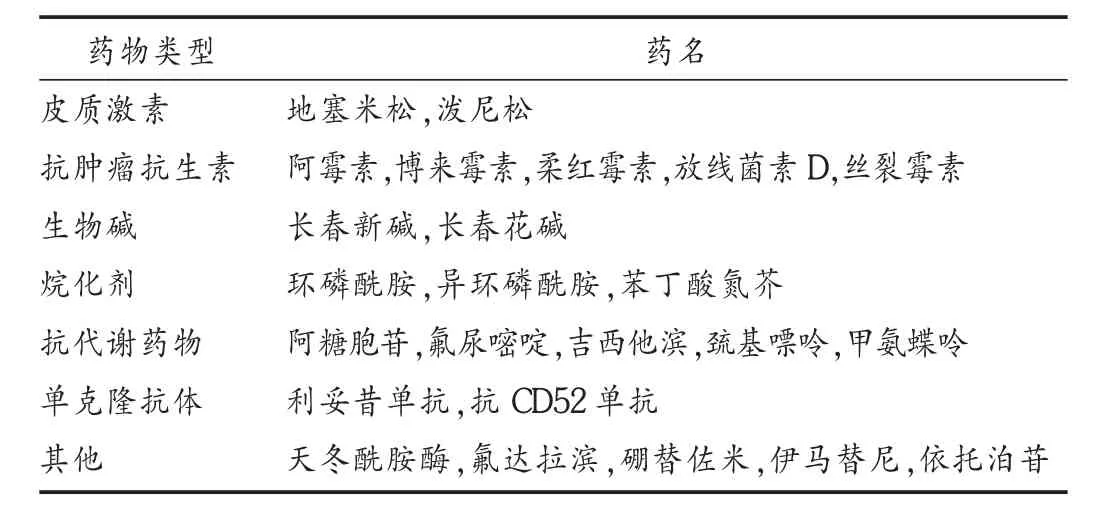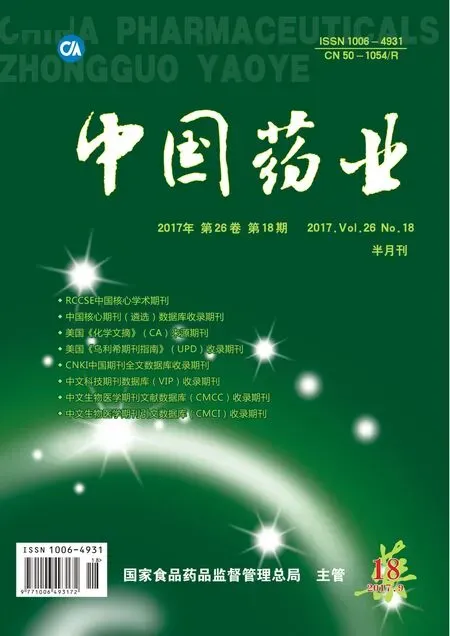免疫抑制治疗患者乙型肝炎病毒再激活防治进展
2017-09-28廖成成
廖成成
(广西医科大学附属肿瘤医院,广西 南宁 530021)
·专论·
免疫抑制治疗患者乙型肝炎病毒再激活防治进展
廖成成
(广西医科大学附属肿瘤医院,广西 南宁 530021)
目的为防治免疫抑制治疗患者乙型肝炎病毒(简称乙肝病毒,HBV)再激活提供参考和建议。方法 通过文献检索,回顾性分析了免疫抑制治疗患者HBV再激活的诊断、高危因素、治疗药物种类,并按照分层治疗的原则系统归纳了药物防治策略及病情监测手段等。结果与结论 免疫抑制治疗患者易发生HBV再激活。抗病毒治疗的启停时机、危险分层及治疗过程中乙肝病毒激活相关指标的监测是防控的关键。
乙型肝炎病毒;再激活;免疫抑制;防治;进展
Abstract:Ob jective To provide references and suggestions for the prevention and treatment of hepatitis B virus(HBV)reactivation in patients with immunosuppressive therapy.M ethods The literatures about the diagnosis,high risk factors and therapeutic drug types of the patients with HBV reactivation with immunosuppressive therapy were reviewed.In accordance with the principles of stratified treatment systematically summarized the drug control strategies and disease monitoring methods.Resu lts and Conclusion After immunosuppressive therapy,the patients prone to reactivation of HBV.Antiviral treatment of the start and end of the time,risk stratification and treatment of HBV activation in the monitoring of the relevant indicators is the key to prevention and control.
Key words:hepatitis B virus;reactivation;immunosuppression;prevention and treatment;progress
据统计,全球约有2.5亿慢性乙型肝炎病毒携带者[患者乙型肝炎表面抗原(HBsAg)阳性][1]。乙型肝炎病毒(简称乙肝病毒,HBV)的总体流行率为3.6%[2],中国居民感染率为7.2%[3]。HBV再激活虽然可自发,但高发人群主要集中在免疫抑制治疗的患者,尤其是需要长期、大量使用化学治疗(简称化疗)药、皮质激素、单克隆抗体等免疫功能抑制药治疗的肿瘤、器官移植、风湿免疫疾病患者。如携带HBV的免疫抑制治疗患者未进行恰当的预防和治疗,轻者可导致治疗中断,影响后续治疗的实施,重者可导致血清转氨酶水平持续增高,暴发急性肝功能衰竭,甚至导致死亡[4]。为此,笔者对行免疫治疗的患者HBV再激活的相关文献进行了综述,回顾了HBV再激活诊断、高危因素及药物种类,并按照分层治疗的原则系统地归纳了药物防治策略及病情监测手段等。现介绍如下。
1 HBV再激活的定义及诊断
HBV再激活,是指非活动性的HBV感染患者失去针对HBV的免疫控制,在免疫重建过程中和/或免疫重建后,病毒复制突然增加。事实上,HBV再激活在国际上并无统一的诊断标准,目前使用得较多的为Perrillo R标准[5]:先前有HBV携带史的患者HBV DNA检测阴性,现血清HBV DNA水平转阳;当患者基线HBV DNA检测阳性时,其升高超过100 U/m L;乙肝两对半[包括乙型肝炎表面抗原及表面抗体(HBsAg,HBsAb),乙型肝炎e抗原及e抗体(HBeAg,HBeAb)和乙型肝炎核心抗体(抗 HBc)]的血清学逆转(如先前HBsAg阴性/抗HBc阳性向HBsAg阳性转化);排除其他感染。
2 HBV再激活的高危因素
2.1 病s毒因素
很多因素被认为与HBV再激活相关,在此主要介绍目前较肯定的HBV载量和HBsAg状态2个因素。亦有报道称,HBV的基因型也是其高危因素,但不同中心的研究有较大分歧[6-7],临床对此看法存在较大争议,尚需更多的高质量研究求证。
基线HBV DNA的高载量:高基线水平HBV DNA(如超过 104IU/m L)患者体内 HBV复制活跃,在Lau等[8]的一项涉及137例接受造血干细胞移植患者的研究中,32例高基线水平的患者(23.36%)发生肝炎,其中有13例(40.62%)发生了HBV再激活。可见,HBVDNA>105U/m L是HBV再激活最重要的危险因素。
HBsAg阳性:与HBsAg阴性者相比,HBsAg阳性患者的HBV再激活风险更高[9]。特别是HBeAg阳性并具有高基线水平的HBV DNA或出现HBsAg血清学逆转时(HBsAg阴性/抗HBc阳性患者向HBsAg阳性转化)。接受免疫抑制治疗的HBsAg阳性肿瘤患者中,有超过14%的患者发生HBV再激活[10];相反,HBsAg阴性伴HBsAb阳性的肿瘤患者HBV再激活的风险明显减小[11]。
2.2 疾病及治疗相关因素
患者的疾病状态、治疗药物的种类及治疗方案的选择都是影响HBV再激活的因素。当有HBV感染的血清学证据的患者接受免疫抑制相关药物(见表1)化疗和/或免疫治疗及需要行器官移植、造血干细胞移植时有较高的HBV再激活风险[11-12]。因此,对以下高风险患者进行治疗时应对HBV再激活的风险进行充分评估,并做好适当的预防措施。

表1 已报道可引起HBV再激活的药物
化疗患者:大多数报道显示,接受标准化疗的实体瘤患者,HBV再激活的风险大于10%[13]。Kim等[14]研究发现,HBsAg阳性的乳腺癌化疗患者,即便严密监测HBV DNA水平,HBV相关的急性肝炎发生率仍高达20%。事实上,任何化疗方案都有可能导致HBV再激活,但不同肿瘤的异质性和化疗方案均被认为是HBV再激活的高危因素。例如,在血液系统肿瘤中,HBV再激活的风险更大。据报道,16.3%~55.0%的淋巴瘤患者可在使用免疫化疗(如利妥昔单抗+CHOP方案)后发生 HBV再激活[15]。其原因是,化疗方案中同时含有利妥昔单抗、激素类药物、细胞毒药物,同时抑制了患者的体液免疫及细胞免疫,且利妥昔单抗半衰期较长,导致HBV复燃的概率大大增加,死亡率高达50%。
自身免疫性疾病患者:患者的HBV感染率要低于普通人群[16],这可能与干扰素(IFN)及其相关基因过表达引起自身反应的T细胞功能增强有关[17]。但已有系列病例报道证实,携带HBV的克罗恩病患者在接受肿瘤坏死因子(TNF)抑制剂英夫利昔单抗治疗的中可能出现再激活。在80例接受英夫利昔单抗克罗恩病患者的研究中,HBsAg阳性患者死亡率高达30%[18]。此外,常见的相关药物还有激素、甲氨蝶呤及优特克单抗(ustekinumab)等。这类患者需长期使用免疫抑制类药物,其激活率及HBV激活相关死亡率与用药时间及剂量强度密切相关。
移植患者:HBV再激活亦可出现在实体器官移植和造血干细胞移植的患者中。特别是HBsAg阴性的患者在行异体器官或异基因造血干细胞移植时会出现血清学逆转,从而引起血清学复燃[19]。此外,供者的隐性感染也是一个不可忽视的因素,一项对造血干细胞移植捐赠者的队列研究发现,在香港的隐性感染率达15.3%[20]。
3 风险分层
风险分层是精准治疗的重要一步,有助于对导致患者发病的高危因素及预后进行初步判断,为个体化治疗打下基础。美国肝病研究学会(AASLD)对免疫抑制治疗中患者HBV再激活进行了风险分层[21],详见表2。

表2 HBV再激活风险分层
4 防治建议
4.1 治疗时机选择
低风险或极低风险:尚无相关研究支持HBV再激活的低风险患者需要进行预防性治疗。多数指南建议进行HBV DNA监测,以便能及早发现HBV再激活并开始适当的治疗[22-23]。
中等或以上风险:由表2可知,中等或以上风险的患者属HBV再激活的高危人群。有研究表明,HBV再激活患者发生重症肝炎或肝功能衰竭的概率高达25%~50%,一旦丙氨酸氨基转移酶(ALT)、天门冬酸氨基转移酶(AST)与HBVDNA载量同时升高,补救性的措施难以有效逆转向肝功能衰竭的转化,建议进行肝脏移植,但疗效并不确切[24]。故患者满足诊断标准应立即开始治疗,而不应该根据临床症状来判断治疗介入的时机。
预防性治疗的启动时机:许多研究证实,对HBV隐性感染者在免疫抑制治疗之前或同时启动的抗病毒治疗可降低HBV再激活的风险。但并无数据表明在启动免疫抑制治疗前应该进行多长时间的抗病毒治疗。Hwang等[25]研究达成的专家共识建议,大多数患者可在免疫抑制治疗的同时启动抗病毒治疗,但对于具有高基线HBV DNA水平(>104U/mL)的患者,建议推迟免疫抑制治疗,直到HBV DNA水平小于103U/m L。
4.2 治疗药物选择
拉米夫定常用于HBV再激活的预防。随着研究的逐渐深入,拉米夫定的耐药率较高,甚至在HBV低载量的患者仍可发生耐药。目前,美国肝脏病研究协会推荐使用恩替卡韦或新一代核苷酸类逆转录酶抑制剂(如替诺福韦酯)进行治疗,先前对拉米夫定耐药的患者可优选替诺福韦酯治疗,但替诺福韦酯对肾功能的影响较恩替卡韦大,临床应慎用。然而,抗病毒治疗降低HBV再激活患者重症肝炎发病率和病死率的证据并不多,多数报道仅显示进行早期抗病毒治疗可改善临床预后[3,26]。
4.3 监测策略
危险分层为低危或极低危的患者(通常为抗HBc阳性,伴或不伴HBsAb阳性),推荐在化疗和免疫抑制治疗中及治疗后进行定期的HBV相关指标检测。对于基线可检测到HBV DNA的患者,需每月进行相关指标监测。对于基线检测不到HBV DNA的患者,应每3个月监测相关指标。
4.4 治疗持续时间
预防和治疗的持续时间大致相同,主要取决于免疫抑制的类型、化疗方案的选择及患者的基线HBV DNA水平等。一般来说,化疗结束后至少应进行6个月的抗病毒治疗。如使用利妥昔单抗(CD20单克隆抗体)的患者,因考虑到B细胞功能恢复的滞后性,建议停药后至少进行12个月的治疗。此外,对于行异体器官移植、异基因造血干细胞移植等需要使用长期抗排斥药物的患者需延长治疗时间,并且在抗病毒治疗结束后进行长期的随访及监测,确保没有肝炎的活动。
5 结语
目前,根据现有文献和指南,免疫抑制治疗患者的HBV再激活防治已有了较清晰的思路和对策,但详细的用药指导、药物的启停时机、风险分层等仍缺乏高级别的循证医学证据,此外,药物的成本与收益比较高、发病后治疗难度大、病死率较高都是亟待攻克的难题。
[1]Schweitzer A,Horn J,Mikolajczyk RT,et al.Estimations ofworldwide prevalence of chronic hepatitis B virus infection:a systematic review of data published between 1965 and 2013[J].Lancet(London,England),2015,386(10003):1546-1555.
[2]Zhang Q,QiW,Wang X,et al.Epidemiology of Hepatitis B and Hepatitis C Infections and Benefits of Programs for Hepatitis Prevention in Northeastern China:A Cross-Sectional Study[J].Clinical Infectious Diseases,2015,62(3):305-312.
[3]CuiY,Jia J.UpdateonepidemiologyofhepatitisBand C in China[J].Journal of Gastroenterology and Hepatology,2013,28(Suppl 1):7-10.
[4]Gupta S,Govindarajan S,Fong T,et al.Spontaneous reactivation in chronic hepatitis B:patterns and natural history[J].Journal of ClinicalGastroenterology,1990,12(5):562-568.
[5]Perrillo RP,Gish R,Falck-Ytter YT.American Gastroenterological Association institute technical review on prevention and treatment of hepatitis B virus reactivation during immunosuppressive drug therapy[J].Gastroenterology,2015,148(1):221-244.
[6]Borentain P,Colson P,Coso D,et al.Clinical and virological factors associated with hepatitis B virus reactivation in HBsAg-negative and anti-HBc antibodies-positive patients undergoing chemotherapy and/or autologous stem cell transplantation for cancer[J].Journal of Viral Hepatitis,2010,17(11):807-815.
[7]Ozasa A,Tanaka Y,Orito E,et al.Influence of genotypes and precore mutations on fulminant or chronic outcome of acute hepatitis B virus infection[J].Hepatology,2006,44(2):326-334.
[8]Lau GKK,Leung Y,Fong DYT,et al.High hepatitis B virus(HBV)DNA viral load as themost important risk factor for HBV reactivation in patients positive for HBV surface antigen undergoing autologous hematopoietic cell transplantation[J].Blood,2002,99(7):2324-2330.
[9]Dhedin N,Douvin C,Kuentz M,et al.Reverse seroconversion of hepatitis B after allogeneic bone marrow transplantation:A retrospective study of 37 patients with pretransplant anti-HBs and anti-HBc[J].Transplantation,1998,66(5):616-619.
[10]Cil T,Altintas A,Pasa S,et al.Lamivudine for the prevention of hepatitis B virus reactivation in hepatitis-B surface antigen(HBSAG) seropositive cancer patients undergoing cytotoxic chemotherapy[J].Leukemia&Lymphoma,2008,49(5):939-947.
[11]Tanaka H,Sakuma I,Hashimoto S,et al.Hepatitis B reactivation in amultiplemyeloma patientwith resolved hepatitis B infection during bortezomib therapy:case report[J].JClin Exp Hematop,2012,52(1):67-69.
[12]Kawsar HI,Shahnewaz J,Gopalakrishna KV,et al.Hepatitis B reactivation in cancer patients:role of prechemotherapy screening and antiviral prophylaxis[J].Clinical Advances in Hematology&Oncology,2012,10(6):370-378.
[13]Paul S,Saxena AP,Terrin N,etal.Hepatitis B Virus Reactivation and Prophylaxis During Solid Tumor Chemotherapy:A Systematic Review and Meta-analysis[J].Annals of Internal Medicine,2016,164(1):30-40.
[14]Kim MK,Ahn JH,Kim SB,et al.Hepatitis B reactivation during adjuvant anthracycline-based chemotherapy in patients with breast cancer:a single institution′s experience[J].The Korean Journal of Internal Medicine,2007,22(4):237-243.
[15]YeoW,Chan TC,Leung NW,et al.Hepatitis B virus reactivation in lymphoma patients with prior resolved hepatitis B undergoinganticancer therapy with or without rituximab[J].JClin Oncol,2009,27(4):605-611.
[16]伍春霞,曾爱中.系统性自身免疫性疾病370例乙型肝炎病毒 感染临 床分析[J].现 代医药卫 生,2015,31(14):2161-2162.
[17]Zhao J,Qiu M,Li M,et al.Low prevalence of hepatitis B virus infection in patientswith systemic lupuserythematosus in southern China[J].Rheumatology International,2010,30(12):1565-1570.
[18]Esteve M,Saro C,Gonzálezhuix F,et al.Chronic hepatitis B reactivation following infliximab therapy in Crohn′s disease patients:need for primary prophylaxis[J].Gut,2004,53(9):1363-1365.
[19]Hammond SP,Borchelt AM,Ukomadu C,et al.Hepatitis B Virus Reactivation following Allogeneic Hematopoietic Stem Cell Transplantation[J].Biology of Blood&Marrow Transplantation Journal of the American Society for Blood&Marrow Transplantation,2009,15(9):1049-1059.
[20]HuiCK,Sun J,Au WY,etal.Occult hepatitis B virus infection in hematopoietic stem cell donors in a hepatitis B virus endemic area[J].Journal of Hepatology,2005,42(6):813-819.
[21]Di Bisceglie AM,Lok AS,Martin P,et al.Recent US Food and Drug Administration warnings on hepatitis B reactivation with immune-suppressing and anticancer drugs:just the tip of the iceberg?[J].Hepatology,2015,61(2):703-711.
[22]王贵强,王福生,成 军,等.慢性乙型肝炎防治指南(2015年更新版)[J].临床肝胆病杂志,2015,31(12):1941-1960.
[23]Sarin SK,KumarM,Lau GK,etal.Asian-Pacific clinicalpractice guidelines on themanagement of hepatitis B:a 2015 update[J].Hepatology International,2016,10(1):1-98.
[24]Shih CA,Chen WC,Yu HC,et al.Risk of Severe Acute Exacerbation of Chronic HBV Infection Cancer PatientsWho Underwent Chemotherapy and Did Not Receive Anti-Viral Prophylaxis[J].PLoSOne,2015,10(8):e0132426.
[25]Hwang JP,Lok AS.Management of patientswith hepatitis B who require immunosuppressive therapy[J].Nature Reviews Gastroenterology&Hepatology,2014,11(4):209-219.
[26]Picardi M,Selleri C,De RG,et al.Lamivudine treatment for chronic replicative hepatitis B virus infection after allogeneic bone marrow transplantation[J].Bone Marrow Transplantation,1998,21(12):1267-1269.
Progress of Prevention and Treatment of Hepatitis B Virus Reactivation in Patients w ith Imm unosuppressive Therapy
Liao Chengcheng
(Affiliated Tumor Hospital of Guangxi Medical University,Nanning,Guangxi,China 530021)
R969.4;R979.5;R512.6+2
A
1006-4931(2017)18-0001-04
10.3969/j.issn.1006-4931.2017.18.001
2017-05-09;
2017-06-06)
廖成成,硕士研究生,主治医师,研究方向为恶性肿瘤化疗,(电话)0771-5390813(电子信箱)mylcc@qq.com。
